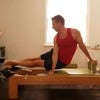Description
About This Video
Transcript
Read Full Transcript
Hi Rachel. Hi Amy. Nice to see. Oh, I'm back in boulder. Here I am with a good friend of mine, I think. Yes. And she has something special to share. I think about a feat and something kind of near to my heart about my own feet. So what you've got, so this, this is also a Joe [inaudible] piece of equipment.
He call it the toe corrector. You might hear toad Gizmo. Um, it, he made actually two pieces of equipment specifically for feet. That's how important he thought feet were in the whole scheme of living. And so the toe corrector has many exercises, but I'm going to show one that you can do at home really easily. You can sit on the side of your bed before you go to bed or when you wake up in the morning, you can sit in a chair, you can find a place that feels comfortable to you. You can do as much or as little of it as you like one toe or all 10.
Um, I'm gonna show, I'm gonna do it for Amy on one foot and then I'm going to have her do it on her other foot so that you can see the different methods that person might use to get the most out of what they're doing, which is a very small thing. So, but at first I'm going to ask Amy to just kind of stand here for a minute, sort of get a feel for what are my feet feel like on the floor? Where am I in gravity? You know, do I feel tension in my low back or my neck, whatever. Take stock a little bit so that you can have, and this is a good thing to do before any little homework exercises you can have a before and an after to prove to yourself that yes, indeed that was worth it because I feel better in these ways. Okay, so Amy's taken stock. So now she's going to sit up on the Cadillac with her feet on the, um, short box. Now the toe correctors that you can buy, uh, out in the world, it looks something like this. These are balanced bodies. Tow Gizmos, grots makes them, they look a little different.
And um, one is easy and one is much harder and you can make your own. You can get used here I have, I went to staples and I got big rubber bands and I tied them together, which gives me more of the distance so that the legs can be a little easier, a little further apart from one another. Um, but you can do it with the broccoli rubber bands as big, thick, purple and blue ones and you can use those too. So you can find what works too thin. Probably wouldn't feel comfortable. You could use live strong bracelets. Um, you could make a Chinese jump rope. Okay. So you can do any of those kinds of things as long as it gives you some resistance. And um, in this particular exercise you could be holding it from the top or you could be holding it with all your fingers from the knot.
That part doesn't matter cause we're not going to be using the official Toe Gizmo anyway. All right, so you can start at the big toe or the little toe. Either way. And we're going to go one an after another and you can be, you will get product, good product out of this no matter how well you do the exercise. So don't worry too much about that. But if you're a [inaudible] teacher and you're going to be teaching this to other clients, then you can watch a little bit how we maybe twist the toe or we turn the toe a little bit so that we get really good alignment as well as just good work in the foot. Okay.
So the foot is the very beleaguered part of our body. We either put too good or too bad shoes on it. We're always walking on very flat surfaces anymore. And so the foot needs all the help we can give it. In addition, when we do help it and it does its job for us, it acts like this trampoline that supports not just the bones of the foot and there are 26 bones in that foot, but it supports the ankle, the knee, the hip, the pelvic floor, the abdomen, the diaphragm, and probably your brain. So, um, so the more you can do with your foot, the more lively and part of the rest of your body. Your foot is the healthier everything else in your body will be.
All right. So as we start the toe corrector, I'm going to put it around one toe and I'm going to try and put it close to the end of her toe, like at the final joint as opposed to in the webbing. Okay? And if that feels too insecure, then go ahead and put it in the webbing. I'm going to ask Amy to leave her toes down, not resist me, but just leave them down. I'm going to pick her big toe up with a rubber band. So I pick it up and she's going to feel a stretch as far as she feels it could go to the middle of her arch, might go to the end of her big toe, and then she's going to pull me down. So I'm gonna let her a little bit and she's going to pull me. So I pull her up.
You do three to five on each toe, and she pulls down. So you'll notice on Amy's foot, she has a Bunyan like many of us do, all post dancers do. And so I'm going to try and and bring, encourage her toe to come down over here. So I'm giving her a little stretch, a little traction, and aligning the muscles and tendons a little bit better for her. And she could do that herself. Feels great and it's not complicated. It's like, oh that looks right. Okay, so that's all for that toe. And then we're going to move to the second toe.
We're going to wrap the rubber band around the second toe. I could help you and probably you'd said you will do the other foot yourself. And then she can put all her toes down and I'm gonna pick her toe up for her and she, you're gonna want to help yourself here, but don't. Yeah, this is right. It's hard not to lift them. So I'm her up and giving her a stretch. And I often think of it as like a popsicle length.
So from the tip of her second toe to where it might end, think of it as a pox popsicle stick that might end in here. So we're searching for a stretch that deep into the arch. We may get it, we may not. And then she pulls me down and I pull her up and she pulls me down. Oh, I feel on my calf. Yeah. And what you'll start feeling it perhaps also in your hamstrings.
So depending on how related your one part of your body is to another less time and you pull me down. Interesting. Right? So the sole of the foot on a certain line of muscle is stretching and then contracting. Okay. Which is really pious. And then we're going to take it to the third toe and we'll do three of them only. Okay. Okay. And she has to leave all of her other toes down and try not to try to have them not help her. And I pull up and she pulls down and Amy is applaud.
He's teacher and she can do this really well. Chances are you won't look this good or feel this comfortable, but don't worry about that because it's not a competitive thing. It's just you working with your foot. Beautifully done. Can I ask a quick one question while we yeah. Would you recommend this, I think you may have already said this, but um, I'm thinking of my mom who's 83 and some clients I work with who are maybe over 60 or even 70 who are starting to walk a little less efficient. I'm going to say it that way and I've noticed their feet a little less dexterous. And you know, absolutely this, you know, the only, the only, um, impediment to doing this you'll see on your left foot is that you have to bend over and pick up your own toe. Not that it's hard work, but you have to bend over. So, you know, they may have to go slowly, one toe, one day, two dose next week kind of thing, depending how it feels on their back.
Yeah. So I pick her up, she pulls me down. This is harder to feel. Yes. And some toes will be harder than other toes. I pick her up, she pulls me down, she's gonna want to pull down with all the other toes. Not that that's damaging or or bad, it's just inefficient. So when I pick up her fourth toe, it's her fourth toe that we would like her to use to pull down. One more time.
Right. There we go. Usually by the third, third rep, you get it, you know, so that's good. And finally, here's your last one. Okay. Alright. And I pick her up and the little toe as we've read in many, and you pull me down as we've read in many journals is one of those evolutionary, um, pieces of the body that is on the way out along with the appendix and the consoles. So it could be in 500 years, people won't have little toes unless they do pull out a lot of k. Last one, you pull me down. It's hard not to engage the other toes, but all that stretch and use the stretching to contract. Nicely done. That's right. Well done. So now you try it on your other foot.
Okay. So you pick up your own toe with your hand. [inaudible] I'm not telling you the others. Try and, and you can put your other hand there. Yeah. And then pull your big toe down. And if you wish to bring it more over here, yeah. You just pull your arm a little over here. Right. And exhale.
Breathe while you're doing it. Although you do not have to breathe a specific way, just as long as you continue to breathe, it will keep the tension out of your neck and shoulders and back. It helped it by how blower. Okay, good. I did that too. Some Times. Good. And then change toes and pick it up and she's searching for a stretch that goes all the way as far as it can go down through her arch, towards her heel bone. And then when she feels whatever whispery feeling that is, she's going to try and employ it to bring her toe back down.
And so therefore we're doing antagonistic and agonistic muscle groups and we're doing, um, we're pumping the blood through places like how many of us have cold feet even after a workout. It's very challenging to not get the other toes. Yeah. And don't worry too much if they do, you know, it's not going to hurt you in any way. And as you got more familiar with it, just like anything, you would refine how you did it. Right. Nice. Really Nice Amy. Exactly. Yeah. Yeah. And the third and fourth toes are kind of Webb together a little bit anyway, so they often work less well independently.
Oops. Nice. So this one you might want to traction forward a little bit and you could use your left hand or your right hand so you can change your hands to um, you know, if one's getting tired, don't think you have to do the same hand. You can change them. Beautiful. And then toe first. Excellent. Exactly. So [inaudible] look thought and you can only do a few. Okay. So as I said earlier, maybe you do one, you do your big toes one day and that's all you start with.
And you feel that a little bit. And I met a person who had the worst Funyuns I've ever seen in my life. She had been an ex ballet dancer and her feet. She told me that she had the worst Funyuns. I didn't see them because what I saw of her feet, they were fabulous.
And she asked her, how come did you have surgery? And she said, no, I did toe correct. Wow. Every day. Twice a day. Well, and it completely rebuilt her foot. And then you can imagine if the fat, if your basement rots or gets weak, the rest of your house is going to fall and sag and crack. But if the basement foundation is strong, the rest of the house will stay strong. So your feet are very valuable. So I'm going to have Amy stand up now and just like feel your feet against the floor. What do you feel that, yes, a picked up feeling. You might even feel like a little bit of your inner thighs turned on just by chance. You might feel even a little tummy turned on without trying my hamstrings a little bit. A little bit of hamstrings too, because as that, as those lines in the sole of the foot work, stretch and contract.
So do lines in the calves and so do lines in the hamstrings. So coming all the way up to the sitz bones and giving the pelvis some support too. So the toe corrector, if you could do one exercise, I hate to say it this way because I'm sure everyone says it on these podcasts, but if you could do one exercise every day, and that was it, I would do this. I kind of agree. Well, I agree with this. [inaudible] you agree? She agrees in the moment. In the moment. Thank you. Very, you're welcome.
Comments
You need to be a subscriber to post a comment.
Please Log In or Create an Account to start your free trial.


























